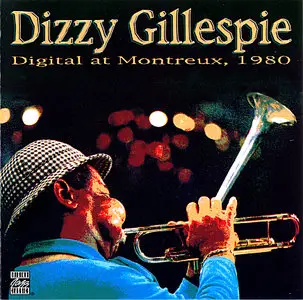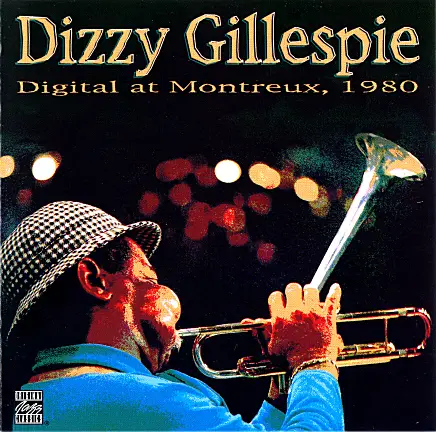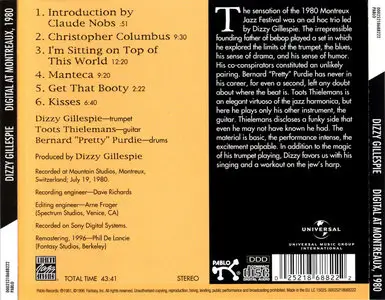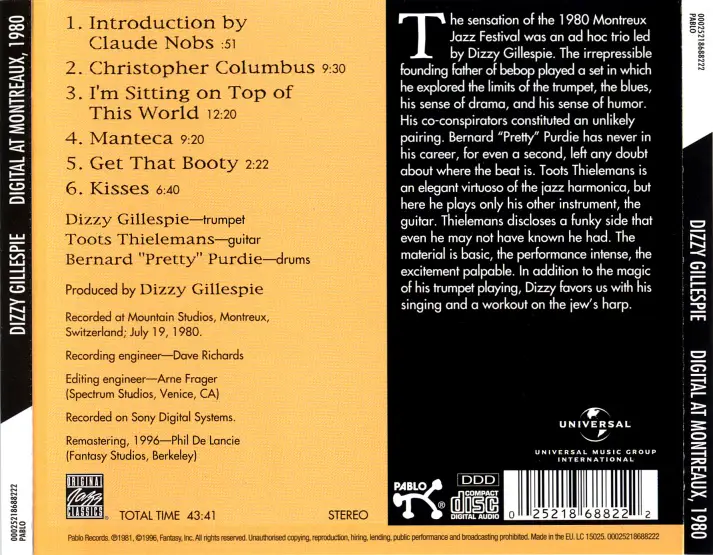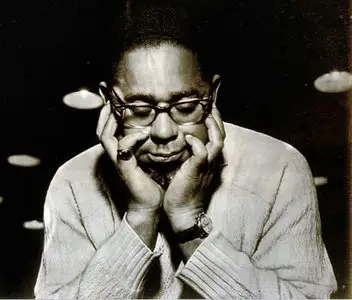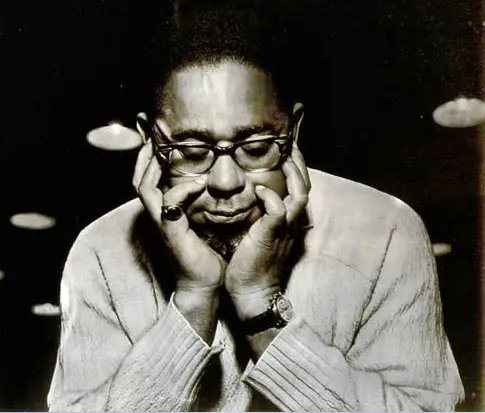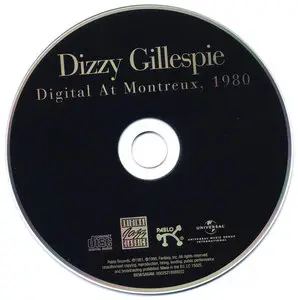Dizzy Gillespie - Digital at Montreux, 1980 (1996)
Jazz | EAC Rip | FLAC (tracks)+CUE+LOG | mp3@320 | 245 MB. & 103 MB.
300dpi. Complete Scans (JPG) - 15 MB. | WinRar, 3% recovery
Audio CD (1996) | Label: Pablo/OJC | Catalog# 0002521-8688222 | 43:43 min.
Jazz | EAC Rip | FLAC (tracks)+CUE+LOG | mp3@320 | 245 MB. & 103 MB.
300dpi. Complete Scans (JPG) - 15 MB. | WinRar, 3% recovery
Audio CD (1996) | Label: Pablo/OJC | Catalog# 0002521-8688222 | 43:43 min.
Review by Ron Wynn ~allmusicTracklist:
A 1980 date with trumpeter Dizzy Gillespie playing in an unusual trio setting with guitarist Toots Thielemans and drummer Bernard Purdie. Purdie, a consummate funk and R&B percussionist, makes the switch to mainstream material adequately, while Gillespie and Thielemans establish a quick, consistent rapport.
01. Introduction by Claude Nobs (0:51)
02. Christopher Columbus (9:47)
03. I'm Sitting on Top of This World (12:29)
04. Manteca (9:27)
05. Get That Booty (3:45)
06. Kisses (7:25)
Personnel:
Dizzy Gillespie - trumpet
Toots Thielemans - guitar
Bernard "Pretty" Purdie - drums
~allAboutJazz
Born: October 21, 1917 | Died: January 6, 1993 | Instrument: Trumpet
John Birks “Dizzy” Gillespie, one of the greatest Jazz trumpeters of 20th century and one of the prime architects of the bebop movement in jazz, was born in Cheraw, South Carolina and died in Englewood, New Jersey.
Nicknamed “Dizzy” because of his zany on-stage antics, Gillespie, a brass virtuoso, set new standards for trumpet players with his innovative, “jolting rhythmic shifts and ceaseless harmonic explorations” on the instrument during the 1940's period, which ushered in a definitive change in American Jazz music from swing to bebop. The last of nine children, Gillespie was born into a family whose father, James, was a bricklayer, pianist and band leader: Dizzy's mother was named Lottie. Dizzy's father kept all the instruments from his band in the family home and so the future trumpet great was around trumpets, saxophones, guitars and his father's large upright piano (his father tore down one of the walls of the house to get the piano in ) most of his young life. James use to make all of his older children practice instruments but none of them cared for music. Dizzy's father died when he was ten and never heard his youngest son play trumpet, although he did get the chance to hear him banging around on the piano, because Dizzy started trying to play this intrument at a very early age.
In 1930, Gillespie tried learning how to play the trombone but his arms were too short to play it well. That same year he started playing a friend's trumpet and heard one night over the radio a broadcast of Roy Eldridge playing trumpet in Teddy Hill's Orchestra, that was playing at the Savoy Ballroom in New York City. Young Gillespie, then 13, loved Eldridge's playing and the entire band. From that day on, he dreamed of becoming a jazz musician.
In 1933, after graduating from Robert Smalls secondary school, Gillespie received a music scholarship to attend Laurinburg Institute, in North Carolina. He stayed there for two years, studying harmony and theory until his family moved to Philadelphia, Pennsylvania, in 1935. In Philadelphia, Gillespie began playing trumpet with local bands, learning all of his idol Eldridge's solos from records and radio broadcasts: it was in Philadelphia that he picked up his nickname of “Dizzy.”. In 1937, “Dizzy” moved to New York and replaced Eldridge in Teddy Hill's Orchestra. After a couple of years Gillespie moved on to Cab Calloway's band in 1939.
In 1937, Gillespie met his future wife, Lorraine, a chorus dancer at the famed Apollo Theater: they were married in 1940 and remained together until his death. Gillespie worked with many bands during the early 1940's (Chick Webb, Fletcher Henderson, Benny Carter, “Fatha” Hines and Billy Eckstine's seminal band ) before teaming up with Charlie Parker in 1945. Their revolutionary band ushered in the bebop era and was one of the greatest small bands of the 20th century. An arranger and composer, Gillespie wrote some of the greatest jazz tunes of his era: songs such as “Groovin' High”, “A Night in Tunisia” and “Manteca” are considered jazz classics today..
With his trumpet and its upturned, golden bell, goatee, black horn rim glasses and beret, Gillespie became a symbol of both jazz and a rebellious, independent spirit during the 1940's and 50's. His interest in Cuban and African music helped to introduce those music's to a mainstream American audience. When he died he was famous and beloved everywhere and had influenced entire generations of trumpet players all over the world who loved and emulated his playing and his always positive, upbeat, optimistic attitude.
Born: October 21, 1917 | Died: January 6, 1993 | Instrument: Trumpet
John Birks “Dizzy” Gillespie, one of the greatest Jazz trumpeters of 20th century and one of the prime architects of the bebop movement in jazz, was born in Cheraw, South Carolina and died in Englewood, New Jersey.
Nicknamed “Dizzy” because of his zany on-stage antics, Gillespie, a brass virtuoso, set new standards for trumpet players with his innovative, “jolting rhythmic shifts and ceaseless harmonic explorations” on the instrument during the 1940's period, which ushered in a definitive change in American Jazz music from swing to bebop. The last of nine children, Gillespie was born into a family whose father, James, was a bricklayer, pianist and band leader: Dizzy's mother was named Lottie. Dizzy's father kept all the instruments from his band in the family home and so the future trumpet great was around trumpets, saxophones, guitars and his father's large upright piano (his father tore down one of the walls of the house to get the piano in ) most of his young life. James use to make all of his older children practice instruments but none of them cared for music. Dizzy's father died when he was ten and never heard his youngest son play trumpet, although he did get the chance to hear him banging around on the piano, because Dizzy started trying to play this intrument at a very early age.
In 1930, Gillespie tried learning how to play the trombone but his arms were too short to play it well. That same year he started playing a friend's trumpet and heard one night over the radio a broadcast of Roy Eldridge playing trumpet in Teddy Hill's Orchestra, that was playing at the Savoy Ballroom in New York City. Young Gillespie, then 13, loved Eldridge's playing and the entire band. From that day on, he dreamed of becoming a jazz musician.
In 1933, after graduating from Robert Smalls secondary school, Gillespie received a music scholarship to attend Laurinburg Institute, in North Carolina. He stayed there for two years, studying harmony and theory until his family moved to Philadelphia, Pennsylvania, in 1935. In Philadelphia, Gillespie began playing trumpet with local bands, learning all of his idol Eldridge's solos from records and radio broadcasts: it was in Philadelphia that he picked up his nickname of “Dizzy.”. In 1937, “Dizzy” moved to New York and replaced Eldridge in Teddy Hill's Orchestra. After a couple of years Gillespie moved on to Cab Calloway's band in 1939.
In 1937, Gillespie met his future wife, Lorraine, a chorus dancer at the famed Apollo Theater: they were married in 1940 and remained together until his death. Gillespie worked with many bands during the early 1940's (Chick Webb, Fletcher Henderson, Benny Carter, “Fatha” Hines and Billy Eckstine's seminal band ) before teaming up with Charlie Parker in 1945. Their revolutionary band ushered in the bebop era and was one of the greatest small bands of the 20th century. An arranger and composer, Gillespie wrote some of the greatest jazz tunes of his era: songs such as “Groovin' High”, “A Night in Tunisia” and “Manteca” are considered jazz classics today..
With his trumpet and its upturned, golden bell, goatee, black horn rim glasses and beret, Gillespie became a symbol of both jazz and a rebellious, independent spirit during the 1940's and 50's. His interest in Cuban and African music helped to introduce those music's to a mainstream American audience. When he died he was famous and beloved everywhere and had influenced entire generations of trumpet players all over the world who loved and emulated his playing and his always positive, upbeat, optimistic attitude.
Dizzy Gillespie (1917 - 1993)
Produced by Dizzy Gillespie
Recorded at Mountain Studios, Montreux, Switzerland; July 19, 1980
Recording Engineer: Dave Richards
Editing Engineer: Arne Frager (Spectrum Studios, Venice, CA)
Recorded on Sony Digital Systems
Remastering, 1996 - Phil De Lancie (Fantasy Studios, Berkeley)
Art Direction: Phil Carroll
Design: Giles Margerin
Photography: Phil Stern, Darryl Pitt/Encore, Andy Freeberg/Encore
Liner notes by Norman Granz
Exact Audio Copy V0.99 prebeta 4 from 23. January 2008
EAC extraction logfile from 25. May 2008, 16:12
Dizzy Gillespie / Digital at Montreux, 1980
Used drive : LITE-ON CD-RW SOHR-5238S Adapter: 1 ID: 1
Read mode : Secure
Utilize accurate stream : Yes
Defeat audio cache : Yes
Make use of C2 pointers : No
Read offset correction : 6
Overread into Lead-In and Lead-Out : No
Fill up missing offset samples with silence : Yes
Delete leading and trailing silent blocks : No
Null samples used in CRC calculations : Yes
Used interface : Installed external ASPI interface
Gap handling : Appended to previous track
Used output format : Internal WAV Routines
Sample format : 44.100 Hz; 16 Bit; Stereo
TOC of the extracted CD
Track | Start | Length | Start sector | End sector
––––––––––––––––––––––––––––-
1 | 0:00.00 | 0:51.15 | 0 | 3839
2 | 0:51.15 | 9:46.42 | 3840 | 47831
3 | 10:37.57 | 12:29.10 | 47832 | 104016
4 | 23:06.67 | 9:26.63 | 104017 | 146529
5 | 32:33.55 | 3:45.00 | 146530 | 163404
6 | 36:18.55 | 7:24.50 | 163405 | 196754
Track 1
Filename I:\EAC\Montreux 1980\01 - Introduction by Claude Nobs .wav
Pre-gap length 0:00:02.00
Peak level 83.5 %
Track quality 100.0 %
Test CRC ACE39004
Copy CRC ACE39004
Copy OK
Track 2
Filename I:\EAC\Montreux 1980\02 - Christopher Columbus .wav
Peak level 100.0 %
Track quality 100.0 %
Test CRC 7C74A901
Copy CRC 7C74A901
Copy OK
Track 3
Filename I:\EAC\Montreux 1980\03 - I'm Sitting on Top of This World .wav
Peak level 100.0 %
Track quality 99.9 %
Test CRC 394C149B
Copy CRC 394C149B
Copy OK
Track 4
Filename I:\EAC\Montreux 1980\04 - Manteca .wav
Pre-gap length 0:00:01.15
Peak level 100.0 %
Track quality 99.9 %
Test CRC FEB47523
Copy CRC FEB47523
Copy OK
Track 5
Filename I:\EAC\Montreux 1980\05 - Get That Booty .wav
Peak level 100.0 %
Track quality 100.0 %
Test CRC DB0705B3
Copy CRC DB0705B3
Copy OK
Track 6
Filename I:\EAC\Montreux 1980\06 - Kisses .wav
Peak level 100.0 %
Track quality 99.9 %
Test CRC DCD33A11
Copy CRC DCD33A11
Copy OK
No errors occurred
End of status report
EAC extraction logfile from 25. May 2008, 16:12
Dizzy Gillespie / Digital at Montreux, 1980
Used drive : LITE-ON CD-RW SOHR-5238S Adapter: 1 ID: 1
Read mode : Secure
Utilize accurate stream : Yes
Defeat audio cache : Yes
Make use of C2 pointers : No
Read offset correction : 6
Overread into Lead-In and Lead-Out : No
Fill up missing offset samples with silence : Yes
Delete leading and trailing silent blocks : No
Null samples used in CRC calculations : Yes
Used interface : Installed external ASPI interface
Gap handling : Appended to previous track
Used output format : Internal WAV Routines
Sample format : 44.100 Hz; 16 Bit; Stereo
TOC of the extracted CD
Track | Start | Length | Start sector | End sector
––––––––––––––––––––––––––––-
1 | 0:00.00 | 0:51.15 | 0 | 3839
2 | 0:51.15 | 9:46.42 | 3840 | 47831
3 | 10:37.57 | 12:29.10 | 47832 | 104016
4 | 23:06.67 | 9:26.63 | 104017 | 146529
5 | 32:33.55 | 3:45.00 | 146530 | 163404
6 | 36:18.55 | 7:24.50 | 163405 | 196754
Track 1
Filename I:\EAC\Montreux 1980\01 - Introduction by Claude Nobs .wav
Pre-gap length 0:00:02.00
Peak level 83.5 %
Track quality 100.0 %
Test CRC ACE39004
Copy CRC ACE39004
Copy OK
Track 2
Filename I:\EAC\Montreux 1980\02 - Christopher Columbus .wav
Peak level 100.0 %
Track quality 100.0 %
Test CRC 7C74A901
Copy CRC 7C74A901
Copy OK
Track 3
Filename I:\EAC\Montreux 1980\03 - I'm Sitting on Top of This World .wav
Peak level 100.0 %
Track quality 99.9 %
Test CRC 394C149B
Copy CRC 394C149B
Copy OK
Track 4
Filename I:\EAC\Montreux 1980\04 - Manteca .wav
Pre-gap length 0:00:01.15
Peak level 100.0 %
Track quality 99.9 %
Test CRC FEB47523
Copy CRC FEB47523
Copy OK
Track 5
Filename I:\EAC\Montreux 1980\05 - Get That Booty .wav
Peak level 100.0 %
Track quality 100.0 %
Test CRC DB0705B3
Copy CRC DB0705B3
Copy OK
Track 6
Filename I:\EAC\Montreux 1980\06 - Kisses .wav
Peak level 100.0 %
Track quality 99.9 %
Test CRC DCD33A11
Copy CRC DCD33A11
Copy OK
No errors occurred
End of status report
[CUETools log; Date: 20.12.2011 21:26:07; Version: 2.0.9]
[CTDB TOCID: epzzEMs5eABqcSWe5Z8xo3yr5Ro-] found.
[ CTDBID ] Status
[ced457a8] (1/1) Accurately ripped
[AccurateRip ID: 000a1b6b-0037cf8a-4f0a3f06] found.
Track [ CRC ] Status
01 [40eb510d] (2/4) Accurately ripped
02 [8d1604ec] (2/4) Accurately ripped
03 [bff00cf5] (2/4) Accurately ripped
04 [7d4488d6] (2/4) Accurately ripped
05 [36797064] (2/4) Accurately ripped
06 [ad03d381] (2/4) Accurately ripped
Offsetted by 664:
01 [75f084c9] (2/4) Accurately ripped
02 [32b31450] (2/4) Accurately ripped
03 [6ca86eea] (2/4) Accurately ripped
04 [8df8d73b] (2/4) Accurately ripped
05 [836486dc] (2/4) Accurately ripped
06 [af47cfcc] (2/4) Accurately ripped
Track Peak [ CRC32 ] [W/O NULL] [ LOG ]
– 100,0 [A1D6D8F7] [C5A94D9F]
01 83,5 [ACE39004] [A532B183] CRC32
02 100,0 [7C74A901] [6017485D] CRC32
03 100,0 [394C149B] [A72E83F7] CRC32
04 100,0 [FEB47523] [43F54CAE] CRC32
05 100,0 [DB0705B3] [B637CA5D] CRC32
06 100,0 [DCD33A11] [C9AA9521] CRC32
[CTDB TOCID: epzzEMs5eABqcSWe5Z8xo3yr5Ro-] found.
[ CTDBID ] Status
[ced457a8] (1/1) Accurately ripped
[AccurateRip ID: 000a1b6b-0037cf8a-4f0a3f06] found.
Track [ CRC ] Status
01 [40eb510d] (2/4) Accurately ripped
02 [8d1604ec] (2/4) Accurately ripped
03 [bff00cf5] (2/4) Accurately ripped
04 [7d4488d6] (2/4) Accurately ripped
05 [36797064] (2/4) Accurately ripped
06 [ad03d381] (2/4) Accurately ripped
Offsetted by 664:
01 [75f084c9] (2/4) Accurately ripped
02 [32b31450] (2/4) Accurately ripped
03 [6ca86eea] (2/4) Accurately ripped
04 [8df8d73b] (2/4) Accurately ripped
05 [836486dc] (2/4) Accurately ripped
06 [af47cfcc] (2/4) Accurately ripped
Track Peak [ CRC32 ] [W/O NULL] [ LOG ]
– 100,0 [A1D6D8F7] [C5A94D9F]
01 83,5 [ACE39004] [A532B183] CRC32
02 100,0 [7C74A901] [6017485D] CRC32
03 100,0 [394C149B] [A72E83F7] CRC32
04 100,0 [FEB47523] [43F54CAE] CRC32
05 100,0 [DB0705B3] [B637CA5D] CRC32
06 100,0 [DCD33A11] [C9AA9521] CRC32
Thanks to the original releaser.
(flac links are interchangeable, mp3@320 & artwork= single links)


